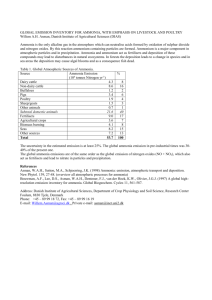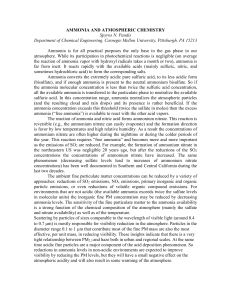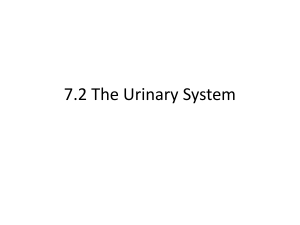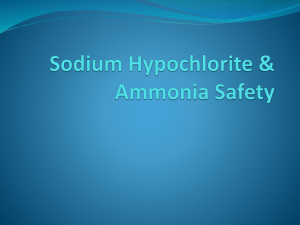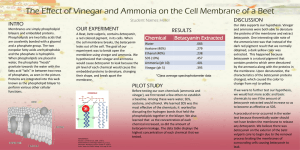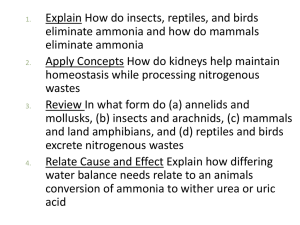Concentrations of NH3 and H2S Gases in Poultry Houses
advertisement
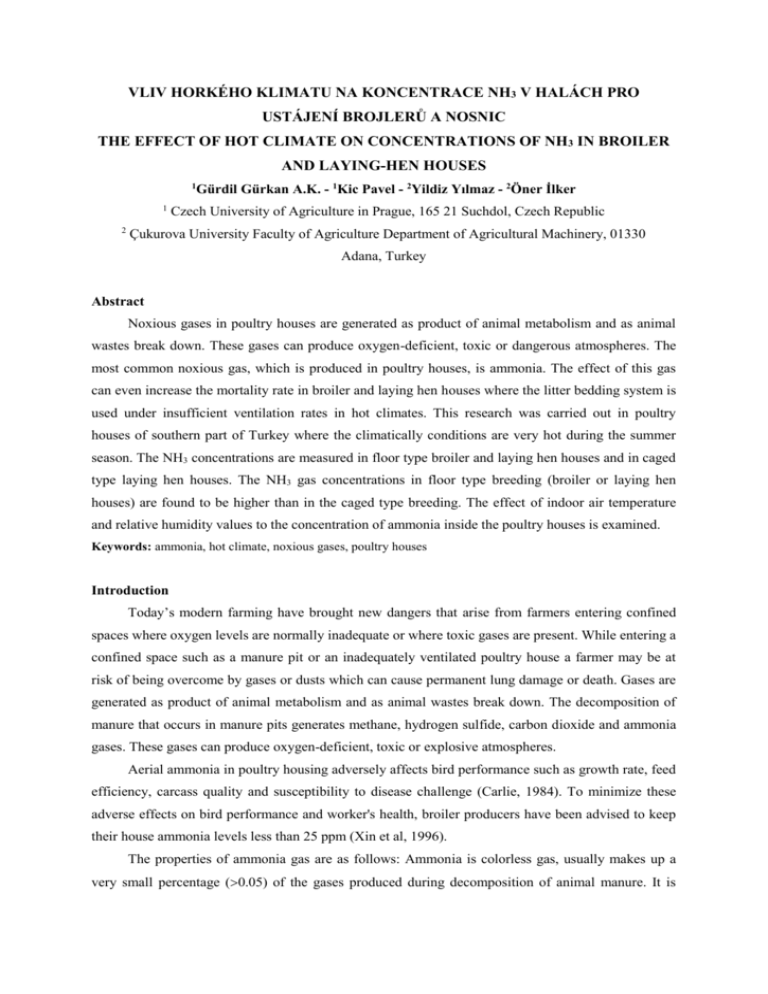
VLIV HORKÉHO KLIMATU NA KONCENTRACE NH3 V HALÁCH PRO USTÁJENÍ BROJLERŮ A NOSNIC THE EFFECT OF HOT CLIMATE ON CONCENTRATIONS OF NH3 IN BROILER AND LAYING-HEN HOUSES 1 1 2 Gürdil Gürkan A.K. - 1Kic Pavel - 2Yildiz Yılmaz - 2Öner İlker Czech University of Agriculture in Prague, 165 21 Suchdol, Czech Republic Çukurova University Faculty of Agriculture Department of Agricultural Machinery, 01330 Adana, Turkey Abstract Noxious gases in poultry houses are generated as product of animal metabolism and as animal wastes break down. These gases can produce oxygen-deficient, toxic or dangerous atmospheres. The most common noxious gas, which is produced in poultry houses, is ammonia. The effect of this gas can even increase the mortality rate in broiler and laying hen houses where the litter bedding system is used under insufficient ventilation rates in hot climates. This research was carried out in poultry houses of southern part of Turkey where the climatically conditions are very hot during the summer season. The NH3 concentrations are measured in floor type broiler and laying hen houses and in caged type laying hen houses. The NH3 gas concentrations in floor type breeding (broiler or laying hen houses) are found to be higher than in the caged type breeding. The effect of indoor air temperature and relative humidity values to the concentration of ammonia inside the poultry houses is examined. Keywords: ammonia, hot climate, noxious gases, poultry houses Introduction Today’s modern farming have brought new dangers that arise from farmers entering confined spaces where oxygen levels are normally inadequate or where toxic gases are present. While entering a confined space such as a manure pit or an inadequately ventilated poultry house a farmer may be at risk of being overcome by gases or dusts which can cause permanent lung damage or death. Gases are generated as product of animal metabolism and as animal wastes break down. The decomposition of manure that occurs in manure pits generates methane, hydrogen sulfide, carbon dioxide and ammonia gases. These gases can produce oxygen-deficient, toxic or explosive atmospheres. Aerial ammonia in poultry housing adversely affects bird performance such as growth rate, feed efficiency, carcass quality and susceptibility to disease challenge (Carlie, 1984). To minimize these adverse effects on bird performance and worker's health, broiler producers have been advised to keep their house ammonia levels less than 25 ppm (Xin et al, 1996). The properties of ammonia gas are as follows: Ammonia is colorless gas, usually makes up a very small percentage (0.05) of the gases produced during decomposition of animal manure. It is easily recognized by its sharp, pungent odor. It is an eye irritant at levels above 20 to 25 ppm. When exposed to levels around 1500 ppm people begin to cough and froth at the mouth. Ammonia is deadly at 5000 ppm. Ammonia has a distinct odor, which humans can detect in concentrations as small as 5 ppm. It is common during winter months for ammonia levels to exceed 25 ppm even under normal winter ventilation rates. Although safety experts debate it, 25 ppm is frequently recommended as a maximum acceptable level for ammonia. If your eyes burn when you enter an enclosed poultry house, you know ammonia levels are at least 20 ppm. Ammonia concentrations in poultry houses must not exceed 25 ppm, generally a limit value of 15 ppm is considered for poultry (Gürdil, 1998). In this research, the effects of indoor air temperature and relative humidity values to the concentration of ammonia inside the broiler and laying hen houses in summer breeding period are examined. Material and Methods Measuring ammonia concentration levels in poultry houses is not so common in Turkey. The measurements are done in broiler and laying hen houses of southern Turkey in summer breeding period, where the summer air temperatures can reach sometimes even to 40 C. An Oldham-MX21 type gas detector was used to predict the ammonia concentrations in poultry houses. The ammonia concentrations are recorded 24 hours permanently at bird level in the poultry houses. The measurements are made always at the center of poultry house. Ammonia concentration measurements in laying hens on litter, laying hens in cages and broilers on litter are made in June, July and August, respectively. Some properties of the poultry houses are given in Table 1. below. Table 1. Some properties of the poultry houses Properties Number of animals (heads) Average live body weight (kg) Density of animals (heads/m2) Density of animals (kg/m2) Moisture content of litter (%w.b) Type of litter Measurement period Broiler on litter 6 000 Place of measurement Laying hen on litter Laying hen in cages 7 000 6 800 0.220 2.0 1.8 10.64 7.29 17 2.34 14.58 30.6 18.14 36.36 - Rice-crust August Saw-dust June July Results and Discussion Ammonia concentrations and their relations with the inside air temperature and relative humidity values in different type of poultry houses in summer breeding season are shown in Figures below: 8 6 Ammonia concentration (ppm) Ammonia concentration (ppm) 8 y = -0,6106x + 17,307 2 R = 0,7354 4 2 0 15 20 25 30 y = 0,0002x4 - 0,0381x3 + 2,4073x2 - 66,49x + 679,4 2 R = 0,834 6 4 2 0 35 20 Inside temperature (oC) 40 60 80 Inside relative humidity (%) (a) (b) Figure 1. Ammonia concentration and its relation with a) inside air temperature and b) relative humidity values in a broiler housed which are raised on litter. As seen from the Figure 1., the maximum ammonia concentration was 7 ppm in the broiler house. The ammonia concentrations are decreased as the inside temperature increased. Decrease of ammonia concentration had the opposite relation with inside relative humidity values. The ammonia 4 4 y = -0,0019x4 + 0,2396x3 - 11,072x2 + 226,81x - 1732,9 R2 = 0,8079 3 2 1 0 20 25 30 35 40 o Inside temperature ( C) (a) Ammonia concentration (ppm) Ammonia concentration (ppm) concentrations are increased as the inside relative humidity of the house increased. 4 3 2 y = -5E-05x + 0,0131x - 1,2014x + 48,615x - 734,7 R2 = 0,7594 3 2 1 0 40 60 80 100 Inside relative humidity (%) (b) Figure 2. Ammonia concentration and its relation with a) inside air temperature and b) relative humidity values in a caged type laying hen house. As seen from the figure, the maximum-recorded ammonia level in the house was 3 ppm. Ammonia concentrations are decreased as the inside air temperature increased. There was a direct relation between the increase of inside relative humidity values and ammonia concentrations. Ammonia concentration (ppm) Ammonia concentration (ppm) 15 12 9 6 3 y = 0,0043x4 - 0,4603x3 + 18,211x2 - 315,95x + 2036,1 R2 = 0,5545 0 15 20 25 30 35 40 15 4 3 2 y = 3E-05x - 0,0061x + 0,4514x - 14,171x + 164,78 R2 = 0,5004 12 9 6 3 0 20 Inside temperature (oC) (a) 40 60 80 Inside relative humidity (%) (b) Figure 3. Ammonia concentration and its relation with a) inside air temperature and b) relative humidity values in a laying hen house, which are raised on litter. As seen from the Figure 3., the maximum ammonia concentration level was 13 ppm in the laying hen house raised on litter. Ammonia concentration was higher at air temperatures from 25 C to 30 C. There was a decrease in ammonia concentration for the inside air temperatures hotter than 30 C. But, ammonia concentrations were increasing as the inside relative humidity values increased. Conclusion In all three different types of poultry breeding the highest ammonia concentrations are recorded in laying hen houses where the poultry are raised on litter. The ammonia concentration levels in broiler houses were also high but, its seen that it's strictly related with the mass and age of broiler and of course with the condition of the litter. As the moisture content of the litter is getting high the ammonia concentration is also increasing. The minimum ammonia concentrations were recorded in caged type laying hen houses. The reasons for this are; first of all the litter is not used in those type breeding systems and the extracts of the laying hens are cleaned periodically with the automatic systems. In all three different types of poultry breeding system it's seen that the increase of ammonia concentrations were in an inverse relation with the increase of inside air temperature values. The ammonia concentrations are decreased with the increased inside air temperatures. But, there was a direct relation between the increase of ammonia concentrations and high relative humidity values inside the houses. The ammonia concentrations are increased as the inside relative humidity increased. Souhrn Škodlivé plyny v drůbežárnách jsou produkovány především metabolismem a rozkladem trusu. Následkem může být nedostatek kyslíku a vznik toxického nebo jinak škodlivého ovzduší. Jedním z nejběžnějších plynů, který je produkován v drůbežárnách je amoniak. Působením tohoto plynu může dojít k vzrůstu úhynů v drůbežárně, kde je v podmínkách horkého klimatu při ustájení na podestýlce nedostatečné větrání. Tento výzkum byl proveden v drůbežárnách na jihu Turecka, kde jsou velmi horké klimatické podmínky během léta. Koncentrace NH3 byla měřena v halách pro výkrm brojlerů a v halách pro nosnice na podestýlce a při klecovém ustájení. Koncentrace NH3 byly vyšší při ustájení brojlerů a nosnic na podlaze než při ustájení v klecích. Sledován byl též vliv vnitřní teploty a relativní vlhkosti vzduchu na koncentraci amoniaku. Klíčová slova : amoniak, horké klima, škodlivé plyny, drůbežárny References Carlie F. S., 1984. Ammonia in Poultry Houses: A Literature Review. World's Poultry Sc. 40:99-111. Gürdil G. A. K., Confined Space Hazards: Air Contaminants in Livestock House. In: Sborník referátu z mezinárodního vědeckého semináře. Nové poznatky v technologických zařízeních v zemědělských a potravinářských provozech (International Scientific Seminars: New Knowledge in Technological Equipment in Agricultural and Food Operations). TF ČZU. Praha, 2-3 Září, 1998, p. 13-15 Xin H., Berry I.L., Tabler G.T., 1996. Minimum Ventilation Requirement and Associated Energy Cost For Aerial Ammonia Control in Broiler Houses. Trans. of the ASAE vol.39 (2):645-648. Contact address: Ing. Gürkan A. K. Gürdil Czech University of Agriculture in Prague Technical Faculty Department of Technological Equipment of Buildings. 165 21 Suchdol, Praha 6 Czech Republic tel: +42 02 2438 3185, fax: +42 02 2092 1361 e-mail: alp@tf.czu.cz

